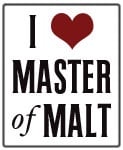
Just thought I would write a quick supplementary post about wood finishes.
So what is a 'wood finish' in this increasingly confusing world of whisky?
When a whisky is said to be 'finished', it means that it has been transfered from the first cask it was being matured in into another, often of a different type, for a second period of maturation*, thus "finishing". For example, after 10 years in an ex-bourbon barrel, a whisky can be put down to 'finish' in an ex-port pipe. The process was pioneered in recent years by Balvenie (William Grant and Sons) and Glenmorangie. While it is quite often the case that such maturation enhances the flavour profile of a given malt, many consumers, critics, and even distillers, frown on the practice as a gimmick that is, more often that not, masking poor whisky.
As far as I am concerned, many finishes are delicious(Balvenie Doublewood, Glenmorangie Port Wood, Laphroaig Quarter Cask, Dalmore Black Pearl, etc.), whether they use the moniker or not, and the practice provides great opportunities for innovation. Now, if it is indeed a case of masking a whisky that didnt mature as well as it could have, then what is the harm in trying to improve the flavours in the hopes that it will one day be good enough to be released as a single malt? The problem lies when the market gets flooded with crap bottlings of finishes (usually from the independent bottlers, sorry, but it is true in my experience) that potentially starts eroding the integrity of the product as a whole or confusing new customers to the wonderful world of whisky. Additionally, there are no standards for how long a whisky must be in the second cask to be considered a 'finish'(typically, 3 months to 24months, but there have been several dubious cases), nor are there any regulations, so far as I know, around how many uses a distiller can get out of the same cask; once I have finished a whisky in a cognac cask, does that cask cease being a cognac cask or can it be used to finish another whisky and still be called a cognac finish? You can see how the integrity of the technique can quickly be undermined by ambitions for profit.
SO DON'T BE CONFUSED. Think of finishes as experiments, something to try when you get bored of the thousand or so other expressions of whisky available to you. What I mean is, I would always recommend trying the standard official bottlings from distilleries before trying single casks or finishes, so don't rush into relationships with finishes until you get to know how what is being finished started.
*- Words you may see on bottles that mean essentially the same thing are 'double matured' and 'cask enhanced'
other 'finishes':
Malt Mission #177
Malt Mission #169
Malt Mission #168
Malt Mission #167
Malt Mission #164
Malt Mission #163
Malt Mission #149
Malt Mission #148
Malt Mission #147
Malt Mission #129
Malt Mission #121
Malt Mission #105
Malt Mission #83
Malt Mission #78
North American Adventure #3
Malt Mission #47
Malt Mission #27
Malt Mission #13
Malt Mission #12
Malt Mission #4





2 comments:
Thanks! That clarified things for me! WSET seem to think this is important to know and it confused me slightly when I got an exam question on it...
Thanks! Clarified things for me! WSET seem to think this is important and it confused me slightly when I had an exam question on this topic...
Post a Comment